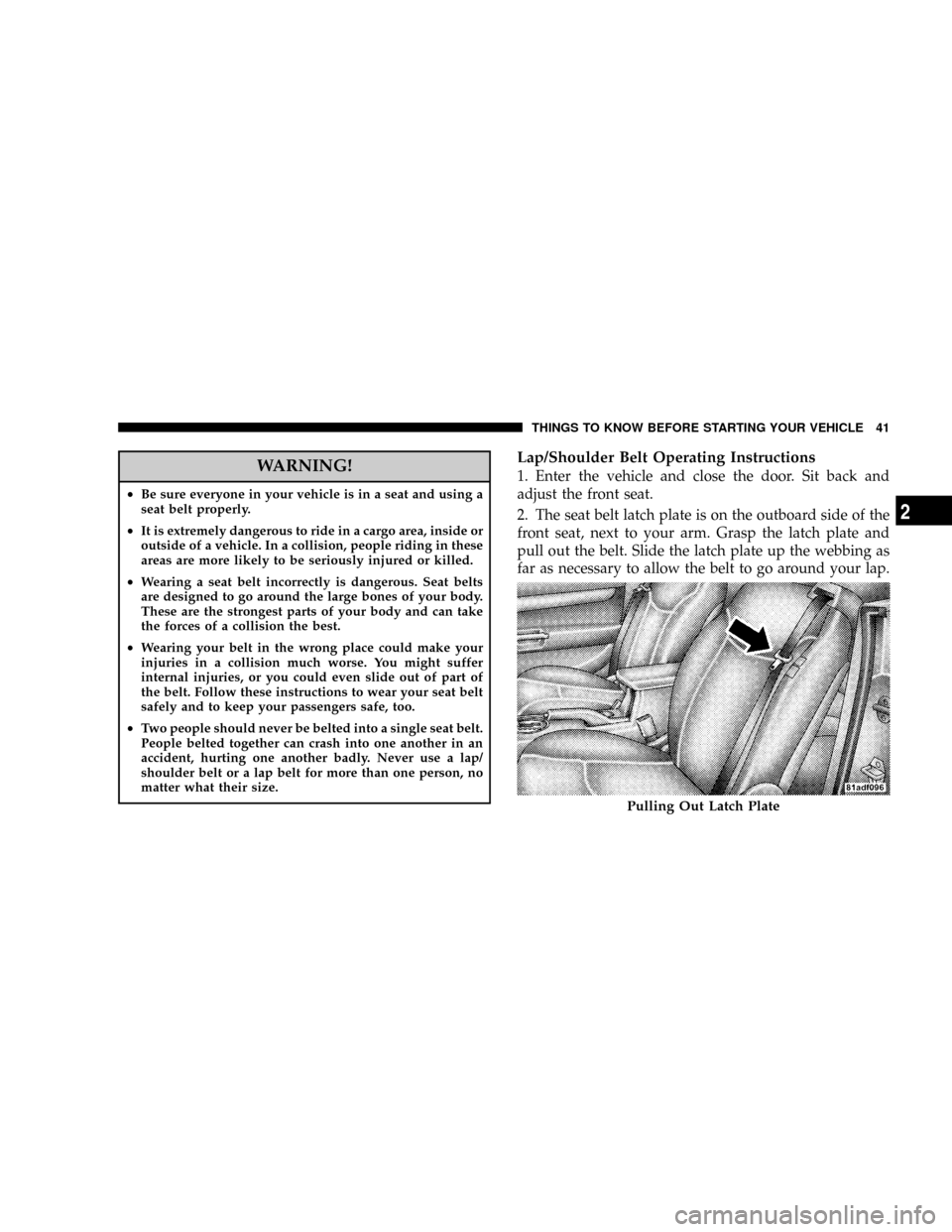2008 CHRYSLER SEBRING CONVERTIBLE belt
[x] Cancel search: beltPage 10 of 454

NUsing The Panic Alarm..................25
NProgramming Additional Transmitters........26
NBattery Replacement....................26
NGeneral Information....................27
mRemote Starting System Ð If Equipped........27
NHow To Use Remote Start................28
mDoor Locks............................29
NManual Door Locks.....................29
NPower Door Locks.....................30
mWindows.............................32
NPower Windows.......................32
NWind Buffeting........................36
mTrunk Lock And Release...................36mTrunk Safety Warning.....................38
NTrunk Emergency Release................38
mOccupant Restraints......................39
NLap/Shoulder Belts.....................40
NLap/Shoulder Belt Untwisting Procedure.....44
NSeat Belt Pretensioners...................45
NEnhanced Seat Belt Reminder System
(BeltAlertt) ..........................45
NAutomatic Locking Mode................47
NSeat Belts And Pregnant Women............47
NSeat Belt Extender......................48
NDriver And Front Passenger Supplemental
Restraint System (SRS) - Airbag............48
NEvent Data Recorder (EDR)...............60
10 THINGS TO KNOW BEFORE STARTING YOUR VEHICLE
Page 33 of 454

There is a single window control on the passenger's door
trim panel, which operates the passenger door window.
The window controls will operate when the ignition
switch is turned to the ON or ACC position, and when
the accessory delay feature is active.
NOTE:
²The door window will lower slightly if it is closed
completely when opening the door. The window will
return to its fully closed position after closing the door.
This action allows the door to open without resistance
and prevents window and top seal damage.
²If a fluttering noise is heard from the rear seat belts
while driving with the windows down, safely bring
the vehicle to a stop and buckle the rear seat belts over
the empty seats. This will keep tension on the seat
belts and remove the fluttering condition.
WARNING!
Never leave children in a vehicle, with the keys in
the ignition switch. Occupants, particularly unat-
tended children, can become entrapped by the win-
dows while operating the power window switches.
Such entrapment may result in serious injury or
death.
Auto Window Down Ð If Equipped
The front window controls on the driver and passenger
door trim panels have an Auto Down feature. These
switches are labeled AUTO to indicate this capability.
Push the window switch past the first detent, release, and
the window will go down automatically.
THINGS TO KNOW BEFORE STARTING YOUR VEHICLE 33
2
Page 39 of 454

inside the trunk, the trunk can be simply opened by
pulling on the glow-in-the-dark handle attached to the
trunk latching mechanism. See picture.
OCCUPANT RESTRAINTS
Some of the most important safety features in your
vehicle are the restraint systems. The following safety
features are standard on your vehicle:
²Three point lap and shoulder belts for all seating
positions.
²Pretensioning and load-limiting retractors for the front
seat belts.
²Advanced dual-stage driver and front passenger air-
bags.
²New active-vent front passenger airbags.
²Knee Bolsters/Blockers for front seat occupants.
²An energy absorbing steering column and steering
wheel.
²Supplemental seat side (Thorax) airbags.
²Supplemental front seat side mounted head airbags.
²Front seat belt retractors that incorporate pretension-
ers to enhance occupant protection by managing oc-
cupant energy during an impact event.
²All seat belt systems (except the driver's) include
Automatic Locking Retractors (ALRs), which lock the
seat belt webbing into position by extending the belt
all the way out and then adjusting the belt to the
desired length to restrain a child seat or secure a large
item in a seat.
If you will be carrying children too small for adult-size
seat belts, your seat belts or the LATCH feature also can
be used to hold infant and child restraint systems.
THINGS TO KNOW BEFORE STARTING YOUR VEHICLE 39
2
Page 40 of 454

NOTE:The front airbags have a dual-stage inflator
design. This allows the airbag to have different rates of
inflation that are based on collision severity.
Please pay close attention to the information in this section.
It tells you how to use your restraint system properly to
keep you and your passengers as safe as possible.
WARNING!
In a collision, you and your passengers can suffer
much greater injuries if you are not properly buckled
up. You can strike the interior of your vehicle or other
passengers, or you can be thrown out of the vehicle.
Always be sure you and others in your vehicle are
buckled up properly.
Buckle up even though you are an excellent driver, even
on short trips. Someone on the road may be a poor driverand cause a collision that includes you. This can happen
far away from home or on your own street.
Research has shown that seat belts save lives, and they
can reduce the seriousness of injuries in a collision. Some
of the worst injuries happen when people are thrown
from the vehicle. Seat belts reduce the possibility of
ejection and the risk of injury caused by striking the
inside of the vehicle.Everyone in a motor vehicle should
be belted at all times.Lap/Shoulder Belts
All the seats in your vehicle are equipped with Lap/
Shoulder Belts.
The belt webbing retractor is designed to lock during
very sudden stops or collisions. This feature allows the
shoulder part of the belt to move freely with you under
normal conditions. However, in a collision, the belt will
lock and reduce the risk of your striking the inside of the
vehicle or being thrown out.
40 THINGS TO KNOW BEFORE STARTING YOUR VEHICLE
Page 41 of 454

WARNING!
²Be sure everyone in your vehicle is in a seat and using a
seat belt properly.
²It is extremely dangerous to ride in a cargo area, inside or
outside of a vehicle. In a collision, people riding in these
areas are more likely to be seriously injured or killed.
²Wearing a seat belt incorrectly is dangerous. Seat belts
are designed to go around the large bones of your body.
These are the strongest parts of your body and can take
the forces of a collision the best.
²Wearing your belt in the wrong place could make your
injuries in a collision much worse. You might suffer
internal injuries, or you could even slide out of part of
the belt. Follow these instructions to wear your seat belt
safely and to keep your passengers safe, too.
²Two people should never be belted into a single seat belt.
People belted together can crash into one another in an
accident, hurting one another badly. Never use a lap/
shoulder belt or a lap belt for more than one person, no
matter what their size.
Lap/Shoulder Belt Operating Instructions
1. Enter the vehicle and close the door. Sit back and
adjust the front seat.
2. The seat belt latch plate is on the outboard side of the
front seat, next to your arm. Grasp the latch plate and
pull out the belt. Slide the latch plate up the webbing as
far as necessary to allow the belt to go around your lap.
Pulling Out Latch Plate
THINGS TO KNOW BEFORE STARTING YOUR VEHICLE 41
2
Page 42 of 454

3. When the belt is long enough to fit, insert the latch
plate into the buckle until you hear a ªclick.ºWARNING!
²A belt that is buckled into the wrong buckle will not
protect you properly. The lap portion could ride too high
on your body, possibly causing internal injuries. Always
buckle your belt into the buckle nearest you.
²A belt that is too loose will not protect you as well. In
a sudden stop, you could move too far forward, increas-
ing the possibility of injury. Wear your seat belt snugly.
²A belt that is worn under your arm is very dangerous.
Your body could strike the inside surfaces of the vehicle
in a collision, increasing head and neck injury. A belt
worn under the arm can cause internal injuries. Ribs
aren't as strong as shoulder bones. Wear the belt over
your shoulder so that your strongest bones will take the
force in a collision.
²A shoulder belt placed behind you will not protect
you from injury during a collision. You are more likely
to hit your head in a collision if you do not wear your
shoulder belt. The lap and shoulder belt are meant to be
used together.
Inserting Latch Plate Into Buckle
42 THINGS TO KNOW BEFORE STARTING YOUR VEHICLE
Page 43 of 454

4. Position the lap belt across your thighs, below your
abdomen. To remove slack in the lap belt portion, pull up
on the shoulder belt. To loosen the lap belt if it is too tight,
lift up on the shoulder belt and pull on the lap belt. A
snug belt reduces the risk of sliding under the belt in a
collision.WARNING!
²A lap belt worn too high can increase the risk of
internal injury in a collision. The belt forces won't be
at the strong hip and pelvic bones, but across your
abdomen. Always wear the lap belt as low as pos-
sible and keep it snug.
²A twisted belt can't do its job as well. In a collision,
it could even cut into you. Be sure the belt is straight.
If you can't straighten a belt in your vehicle, take it to
your dealer and have it fixed.
5. Position the shoulder belt on your chest so that it is
comfortable and not resting on your neck. The retractor
will withdraw any slack in the belt.
Positioning Lap Belt
THINGS TO KNOW BEFORE STARTING YOUR VEHICLE 43
2
Page 44 of 454

6. To release the belt, push the red button on the buckle.
The belt will automatically retract to its stowed position.
If necessary, slide the latch plate down the webbing to
allow the belt to retract fully.
WARNING!
A frayed or torn belt could rip apart in a collision and
leave you with no protection. Inspect the belt system
periodically, checking for cuts, frays, or loose parts.
Damaged parts must be replaced immediately. Do
not disassemble or modify the system. Seat belt
assemblies must be replaced after a collision if they
have been damaged (bent retractor, torn webbing,
etc.).
Lap/Shoulder Belt Untwisting Procedure
Use the following procedure to untwist a twisted lap/
shoulder belt.
1. Position the latch plate as close as possible to the
anchor point.
2. At about 6 to 12 inches (15 to 30 cm) above the latch
plate, grasp and twist the belt webbing 180É to create a
fold that begins immediately above the latch plate.
3. Slide the latch plate upward over the folded webbing.
The folded webbing must enter the slot at the top of the
latch plate.
4. Continue to slide the latch plate up until it clears the
folded webbing.
44 THINGS TO KNOW BEFORE STARTING YOUR VEHICLE